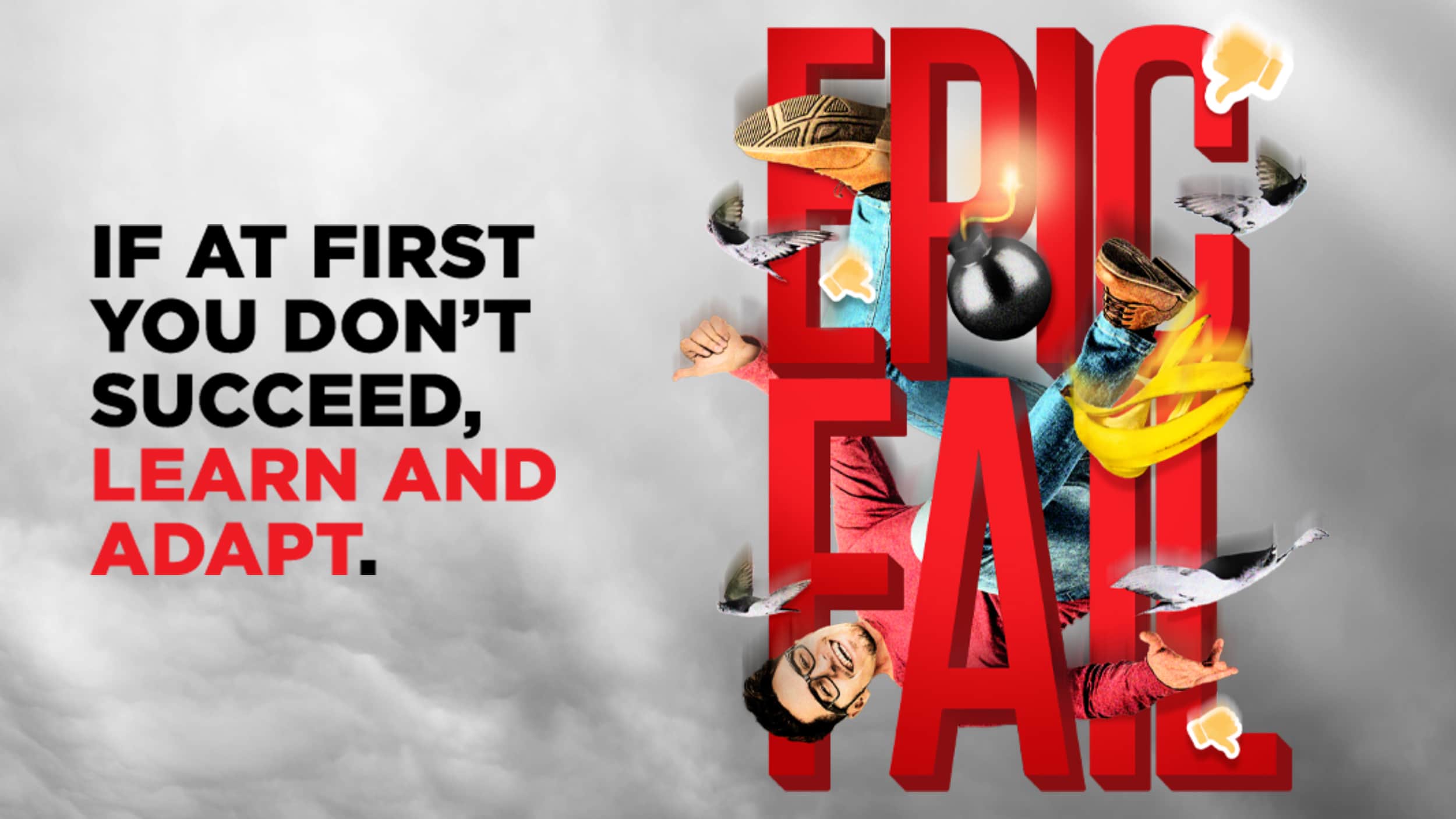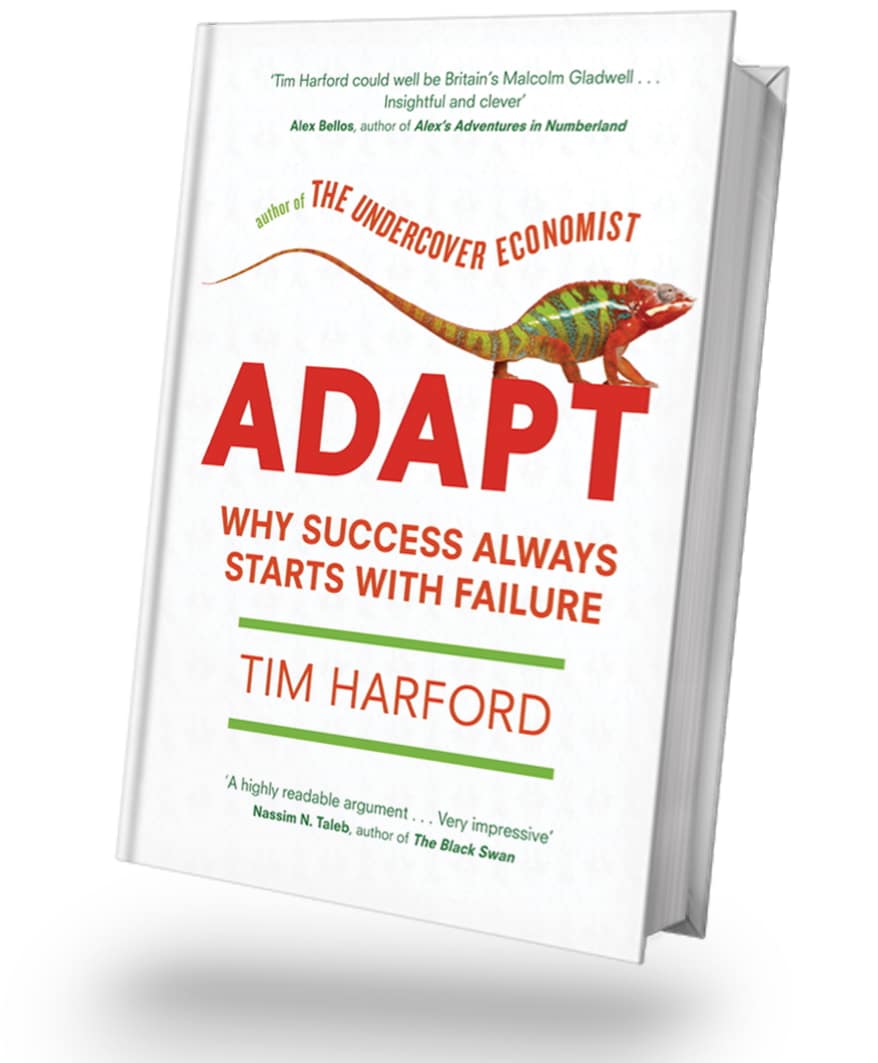
If at first you don’t succeed, learn and adapt.
Published
6 months agoon
WHERE ONCE FAILURE was the domain of losers, it’s now a cause célèbre, a hard-earned badge of redemption and authenticity.
In ads for sports shoes, athletes relish recalling how many times they missed the winning shot; in magazine articles, CEOs take pride in recalling their blunders, politicians and celebrities their lowest moments, even their disgraces. In short, the benefits of failure shouldn’t be news to us. Failure spurs us to innovate, prevent recurring mistakes, and uncover new opportunities.
What’s more, failure comes with tangible costs: wasted time, wasted money, and potentially even the loss of your business (or worse). Plus, even minor missteps can be painful. Disappointment cuts deep, and we stake so much psychologically on being right that denial and blame-shifting remain our default responses when things go wrong.
As a result, despite all the good talk about failure, most businesses continue to do the opposite. They punish mistakes, shoot the messenger, deny errors, blame others, make no systematic effort to study the problem, and basically ignore whatever messages failure has to teach. In the process, they double down on their errant course of action, stifle risk-taking, and take a step toward creating the very thing they are trying to avoid: a terminal misstep.
Although there is no way to take the pain out of failure, you can resolve to avoid making the same mistakes. Read on for insights about how make the best of situations when things go awry, followed by a few tips on how to mitigate or even prevent the worst of the damage.
LET IT SINK IN
German statesman Otto von Bismarck is often reported to have said, “Only a fool learns from his own mistakes. The wise man learns from the mistakes of others.”
However, recent research indicates first-hand experience helps us learn better. Like riding a bike, there are just some things you can’t learn from a book or YouTube video. Experiencing failure builds resilience.
“All the advice tells you not to dwell on your mistakes, to not feel bad,” says Selin Malkoc, co-author of the study and a professor of marketing at Ohio State University’s Fisher College of Business. “But we found the opposite. When faced with a failure, it is better to focus on one’s emotions — when people concentrate on how bad they feel and how they don’t want to experience these feelings again, they are more likely to try harder the next time.”
MAINTAIN PERSPECTIVE
Thinking philosophically about failure can help ensure we respond constructively. Keep in mind that in some mysterious way, the possibility of failure is what makes games worth playing, business worth pursuing, and ultimately life worth living. When there is no challenge, the joy evaporates (try playing a video game designed for four-year-olds and see how long that stays fun!).
The poet Rainer Maria Rilke summed it up nicely: “The purpose of life is to be defeated by ever greater things.” In business, those challenges are waiting every day. Go down valiantly.

KNOW WHAT FAILURE LOOKS LIKE

Recognizing failure can be surprisingly difficult. We’ve been trained that “persistence pays off,” so it feels wrong to cut our losses and label an idea a failure. “Decide what success and failure would look like before you launch an initiative,” says Wharton Business School’s Rita Gunther McGrath, noting that some big corporations build exit strategies into their projects to ensure that doomed or resource-sucking efforts do not drag on.
“Being able to recognize a failure just means that you’ll be able to re-cast it into something more likely to succeed,” adds Tim Harford, author of the book Adapt: Why Success Always Starts With Failure. In such instances, feedback — either in the form of data or third-party reviews — is essential for determining which experiments have succeeded and which have failed. “Get advice, not just from one person, but from several,” he says.
BEWARE YOUR BIASES
The human capacity for self-deception is profound. It thus helps to be aware of the kinds of biases that can undermine a proper evaluation of a project. Among the most common psychological blind spots related to failure are the “God complex” (feelings of infallibility), chasing your losses (taking bigger risks to win back lost money), or hedonic editing (when we try to convince ourselves that a mistake doesn’t matter, or finding some way to reinterpret our failures as successes).
DEBRIEF
When a business venture fails, sure, it sucks. When a military expedition fails, people die. The life-or-death nature explains the military’s relentless “after-action reviews” (AARs) of each combat encounter and combat-training exercise. “As in business, the reasons for success or failure in combat often are not clear,” writes behavioral scientist Francesca Gino, author of Rebel Talent: Why It Pays To Break The Rules At Work And In Life. “AAR participants discuss four key questions: What did we set out to do? What actually happened? Why did it happen? What are we going to do next time?”
Failure reviews aren’t fun, but you must resist the temptation to sweep little disasters under the carpet. You could lose a valuable learning opportunity. “Reviews work best when they are fast and to the point; take place frequently, through good times and bad; and are forward-looking, with an emphasis on learning, not assigning blame,” write Julian Birkinshaw and Martine Haas in Increase Your Return On Failure.
KEEP A FAILURE RÉSUMÉ
A failure résumé — or anti-portfolio or CV of failures or whatever name you give it — is a simple idea: when you fail, write it down. The idea is not to wallow in negative feelings. “Honestly analyzing one’s failures can lead to the type of introspection that helps us grow — as well as show that the path to success isn’t a straight line,” writes Tim Herrera in his “Smarter Living” column for the New York Times. Documenting failures can also help validate your achievements by serving as a reminder of how hard you’ve struggled to succeed.
SWITCH IT UP
A crucial question to ask yourself about your mistakes is, “Am I failing differently each time?” says Steven Levitt, author of the business bestseller Freakonomics. For all our talk here about failure, what we are actually talking about is learning. Fail the same way over and over, and you’re clearly not learning.

EMBRACE RISK
The more you try, the more you’re likely to fail – and that’s OK. As 3M’s legendary chairman William McKnight once said, “The best and hardest work is done in the spirit of adventure and challenge … Mistakes will be made.”
A risk-averse culture, on the other hand, is dangerous. Once you and your team quit innovating and become guardians of the status quo, the end is likely in sight. “One division head I worked with would say to his team members during their performance reviews, ‘Show me your scrap heap,’” recalls Wharton’s Gunther McGrath. “The request perfectly conveys the idea that high achievers will, of necessity, try some things that don’t work out.”
DON’T POINT FINGERS
Building a culture of risk requires resisting natural instincts to immediately assign blame. When Amy Edmondson, a professor in leadership and management at Harvard Business School, discusses failure with executives, she often asks them to consider her Spectrum of Reasons for Failure. This list of causes ranging from deliberate deviation to thoughtful experimentation. “When I ask executives to estimate how many of the failures in their organizations are truly blameworthy, their answers are usually in single digits—perhaps 2 percent to 5 percent,” she reports. “But when I ask how many are treated as blameworthy, they say (after a pause or a laugh) 70 to 90 percent. The unfortunate consequence is that many failures go unreported and their lessons are lost.”
DON’T FRET THE MORAL HAZARD
If people aren’t blamed for failures, what will ensure that they try as hard as possible to do their best work? What stops a business from descending into anything-goes chaos? According to Edmonson, such concerns are based on a false dichotomy: “In actuality, a culture that makes it safe to admit and report on failure can—and in some organizational contexts must—coexist with high standards for performance,” she writes.
Encouraging failure doesn’t mean abandoning supervision, quality control, or respect for sound practices. In fact, it’s just the opposite, argue write Richard Farson and Ralph Keyes, authors of Whoever Makes The Most Mistakes Wins. “Managing for failure requires executives to be more engaged, not less. Astute managers mark the daily progress of small successes and failures with an evenhanded, open curiosity about the lessons learned and the next steps to take.”
FOCUS ON PROCESS
According to Dan Ariely, author of the bestseller Irrationally Predictable, people tend to focus too much on the outcome rather than the process. “Sometimes the idea is very good but the outcome is negative,” he writes. Emphasizing systems over goals and analysis over blame creates an encouraging environment for experimenting and generating good ideas.
Edmonson concurs: “The key is to insist on developing a clear understanding of what happened – not of ‘who did it’ – when things go wrong.” Farson and Keyes recommend eschewing both praise and blame. “Failure-tolerant leaders avoid giving either praise or criticism, preferring to take a nonjudgmental, analytical posture as they interact with staff. And they try to root out the destructive competitiveness built into most organizations,” they write.
HAIL THE BAD-NEWS MESSENGER
“The biggest mistake you can make as a leader is to shoot the messenger and bury the bad news,” write Birkinshaw and Haas. “Big, painful, expensive failures are easy to spot. But in many organizations, any failure that can be hidden is hidden as long as it’s unlikely to cause immediate or obvious harm.”
The goal should be to identify failure early, before it has mushroomed into disaster. Among the ways to do this: creating a shared understanding around the types of failures that employees can expect to happen at work, being accessible as a leader (physically and in terms of personality), and rewarding the messenger who brings up bad news.
FAIL FROM THE FRONT
Far from revealing weakness, admitting mistakes shows a leader’s self-confidence and helps forge closer ties with employees. “A blunder admitted is empathy earned,” write Farson and Keyes. “Leaders who don’t cover up their errors reveal themselves as human—they become people whom others can admire and identify with.” Adds Edmonson: “Only leaders can create and reinforce a culture that counteracts the blame game and makes people feel both comfortable with and responsible for exposing and learning from failures.”

SHARE WHAT YOU LEARN
Although reflecting on individual failures is useful, the real payoff comes from sharing lessons across the organization – or even better, ingraining them into in institutional memory. At Coca-Cola, stories about the failure of New Coke are still told 30 years on. Former CEO Roberto Goizueta got years of one-liners from the fiasco. “Admitting his mistake conveyed to his employees better than a hundred speeches or a thousand memos that ‘learning failures,’ even on a grand scale, were tolerated,” Farson says.
Today, traditional soft drinks now account for less than two-thirds of Coke’s business. “They saw the handwriting on the wall, and they evolved into ready-to-drink teas and coffees and juices and dairy products. Coca-Cola knew it was time to reinvent themselves; to transform from one thing into another. This is why — after a continuing series of mistakes, failures, and course corrections — they will continue to thrive,” says Roy H. Williams, author of The Wizard Of Ads.

GIVE UP THE REINS
It’s not just at the organizational level that failure can be “a gift.” Individuals – including your employees – also can benefit from its didactic embrace. The problem is that many managers are what psychologists call “over-functioners” – they spring into fixing mode, taking control and attacking the issue. As with raising kids, it often helps to let underlings fail to allow them to develop, even if it creates some short-term anxiety or uncertainty. When a person is struggling, ask, “What do you think you should do? Go try it and I’ll give you some ideas, and then you see how it goes.”
USE SYMBOLIC RITUALS
Heroic Failure Awards, Failure Walls (a space in your back room for sharing “growth lessons”), or a Failure Hour (a weekly meeting devoted to improving things that went wrong) can help create an environment in which failures are openly and seriously discussed. “Something magical happens to failure when it’s openly acknowledged,” writes business author Jeff Stibel in a column for Bizjournals.com. “Paradoxically, it becomes less of a big deal.”
Print, Fail, Prevail The Brain Squad shares examples of fiascos with happy endings.
As the old saying goes, everyone makes mistakes; it’s how you respond that defines you. Here, the Brain Squad shares wisdom on how to bounce back, along with a number of specific examples of “jobs gone wrong” that turned out right in the end.
- Make-or-Break Moments
Morgen Masciana, DCG One
I can’t say this enough: how you handle an issue on a project (if one comes up) makes or breaks a client relationship. We’re all human, and mistakes can happen – especially if the project is rushed. In this industry there’s a lot of touch points … at any step, from design to production to shipping and install, there’s a chance that something can happen to put a wrench in the plan, and you have to be quick to pivot to make things work. Clear communication is always needed, and taking emotions out of the equation, so you can steer the project back on track with efficiency. - Don’t Panic
Linda Fong, Fastsigns Oakland/Hayward
We produced graphics for an event for a long-time client, and one important product was the wrong size. Imagine our surprise when the escalator changed – we always take pictures and measurements but didn’t this time because of familiarity. My team handled it seamlessly, and the client was impressed with how we did not appear to be in panic mode. Magic! - Flip the Script
Kim Magraw, Vivid Sign
I get a call on a Wednesday afternoon: “Bob says you need to get up to our facility, Ralphs’ Grocery in Southern California right away.” I drop what I am doing in my office and drive 45 minutes to the truckyard where we decal their fleet. They had a slogan and a large logo on each side of the trailers – Ralphs’ logo and the words, “Lower Prices Higher Standards.” That morning our installer had installed 2 trailers that were repainted. When I drove through the guard shack, there it was: the trailer with the words “Higher Prices Lower Standards.”
I could not remove the lettering fast enough! I installed the new lettering and reported to the office. There I took my beating in silence, and I promised to have a good talk and review install finish work with my team. Bob was gracious and allowed us to maintain the fleet for many more years. No excuses, just fix the problem now, do not point, do not blame, just get it done. Bob had that photo of the trailer on his wall for the next 15 years. - No Hill Too Steep
Jim Dittmer, JDA Creative Color
Virtually any problem can be solved with the right attitude, a little extra time, and a little money – if you catch it soon enough. Everyone who works for us can “push the stop button” when a project is going off the rails, and everyone is encouraged to be a part of the solution. We don’t punish people for making a mistake, and we encourage them to be a part of the solution so it becomes a teaching moment. - Actions Speak Louder
Diana Herrera, Associated Photo & Imaging
There have been many long-term relationships built on the backbone of how we dealt with a difficult situation. Why? Because it shows character. - Strength in Numbers
Jim White, Go Graphix
This industry is riddled with opportunities for mistakes. We recently encountered one where giant stadium banners that required outsourcing were ordered too late. We had the artwork in time, but sat on it a day too long. Result: our customer would not have the banners with their sponsors’ ads up for opening day. Instead, we offered to produce twice as many banners at sizes we could produce in-house and install them on time for opening day.

DON’T FAIL TOO HARD
Resolving to make the most of bad situations is not the same as embracing failure. On the contrary, a spectacular fail – or even series of cascading, minor missteps – can burn holes in the budget, destroy morale, infuriate customers, and sometimes lead to legal trouble and even tragedy. For small business owners, there is the legitimate risk that a major failure — choosing a wrong location, expanding to a new market, or opting not to adopt a new technology – could mean the end of their business. Our final 10 tips can help minimize the damage (and possibly even prevent at truly epic fail):
Contain the Downsides
01To enjoy the benefits of failure, you’ve got to survive the experience. To the extent you can control things, try to fail small and cheaply, perhaps by proceeding incrementally with any risky new venture. Always ask, “What is the minimum viable experiment?” Williams says. It also helps to stick to “adjacencies,” or areas where you have some related business experience. The business world is littered with the dead projects of companies that strayed too far from their core competencies.
Aim Low
02A common mistake even at big corporations is to test new products or services under optimal conditions, Edmondson says. Take the example of a new website rollout. Rather than assume visitors will be tech-savvy, the best approach would be to test the site with limited support, unsophisticated customers, and old computers or phones. Rather than proving that everything could go right, the goal is to discover anything that could possibly go wrong. “Of course, the managers in charge would have to have understood that they were going to be rewarded not for success but, rather, for producing intelligent failures as quickly as possible,” she says.
Make Backup Plans
03 “Expose yourself to lots of different ideas and try lots of different approaches on the grounds that failure is common,” Harford writes. “This approach is far less intimidating than trying to come up with the best idea ever. You need Plan B, Plan C, Plan D. You need a full quiver of arrows.” A fallback position not only makes it easier to be wrong, but also enables taking away a wider range of lessons from each mistake, he says. Ideally, you want to try a mix of off-the-wall ideas and by-the-book practices.

Use Checklists
04In his book The Checklist Manifesto, Dr. Atul Gawande argues that in our complex modern world, failure results not so much from ignorance (not knowing enough about what works) as from ineptitude (not properly applying what we know works). His solution? Checklists.
In medicine, a field where the available well of learning expands exponentially every year, the problem is “making sure we apply the knowledge we have consistently and correctly,” Gawande says. A recent study in UK hospitals suggested that wider use of checklists might prevent a staggering 40 percent of deaths during treatment. If surgeons can fill out checklists, the rest of us should probably be willing to run our expertise by the numbers as well.
Revisit and Reboot
05Revisit your old ideas regularly. For one, the lessons of past failures are likely still relevant. For another, circumstances change. The time for these old ideas may well have arrived.
Imagine Failing Before You Fail
06Post-mortems are a great way to examine what went wrong with a venture. The problem, as the name suggests, is that the “patient” has already died, in a sometimes embarrassing “why didn’t we think of that?” way. To prevent such failures, the Nobel Prize-winning business author Daniel Kahneman suggests something known as a “pre-mortem.” Before launching a new venture, tell your team to imagine they are in the future looking at the aftermath of the disaster. Why did it flop so spectacularly?
This approach removes pressure about being the “skunk at the picnic” – seeming disloyal by being less than positive about the project. In fact, it turns the session into a competition to find ever more convincing reasons for a hypothetical failure. With all these possible mistakes out on the table, you might just be able to make an adjustment to save your project from actually sinking.
If It Ain’t Broke, Experiment
07Understanding why you’re successful is as important as understanding what causes mistakes. So, it is critical to keep looking at data even when things are going well. “Celebrate success, but examine. Ironically, casting a critical eye on your success can better prepare you to avoid failure,” write Francesca Gino and Gary Pisano in an article in the Harvard Business Review (“Why Leaders Don’t Learn from Success”). Gino and Pisano say the right question for leaders of learning organizations to ask is not “What are we doing well?” but rather “What experiments are we running?”
Don’t Let Fear Hold You Back
08In her latest book Big Magic, Elizabeth Gilbert notes that fear can be a sign that something is important to you. The trick, if you can do it, isn’t to ignore fear, or try to conquer it, and definitely not to obey it, but to treat it like an annoying younger sibling and make space for it. She uses the analogy of a road trip. “Fear always comes along for the ride, and that’s fine — but that doesn’t mean you need to let it anywhere near the steering wheel.”
Don’t Let Failure Define You
09A lot of us look to athletes for inspiration. But according to British sports psychologist James Hamilton, many elite athletes have a pretty unhealthy view of success and failure, associating defeat with an all-round failure of the self.
To be sure, this perspective can fuel a drive to put up with huge levels of discomfort and deprivation, but it can also result in risk-avoidance and self-blame when things don’t pan out. A healthier view is to remember that any failure “stands separate” from you, he says.
Find a Podcast
10It may sound a little cheesy, but when things aren’t going well, there’s a fabulous world of inspiration out there — podcasts, YouTube commencement speeches, TED talks, School of Life videos. No end, really, of great people who have experienced what you’re going through and can provide a pick-me-up or reassurance or even tactical guidance.
Designer Ida C. Benedetto told the Creative Independent that she keeps a collection of such talks for when she needs a boost to keep believing in herself (https://bigpicturemag.com/believe-in-yourself). For maximum inspiration, start building your own list.
Advertisement
SPONSORED VIDEO
Printvinyl Scored Print Media
New Printvinyl Scored wide-format print media features an easy-to-remove scored liner for creating decals, product stickers, packaging labels, and more. The precision-scored liner, with a 1.25” spacing on a 60” roll, guarantees a seamless and hassle-free removal process.
You may like

Check Out the Great Info in the July/August Issue

National Workaholics Day, Interns Day, and More July/August Dates for Print Pros

Kill an Obsolete Project, Survey Competitor’s Websites, and More To-Dos for July/August
SUBSCRIBE

Bulletins
Get the most important news and business ideas from Big Picture magazine's news bulletin.
Most Popular
-

 VEHICLE WRAPS + GRAPHICS3 weeks ago
VEHICLE WRAPS + GRAPHICS3 weeks agoAs the Wrap Market Surges, Technology Keeps Improving
-

 Press Releases3 weeks ago
Press Releases3 weeks agoMUTOH Wins 2024 EDP Award “Direct to Shape Printer” for Its XpertJet 1462UF
-

 Case Studies3 weeks ago
Case Studies3 weeks agoAt This Pennsylvania Printer, Color Consistency is King
-

 Case Studies1 week ago
Case Studies1 week agoFormer Frito Lay Delivery Van Becomes an Eye-Catching Catering Vehicle
-

 Benchmarks3 weeks ago
Benchmarks3 weeks ago3 Food Truck Wraps Where Skilled Designers Overcame Tough Technical Challenges
-

 Press Releases2 months ago
Press Releases2 months agoAvery Dennison Sponsors 2024 Design-a-Bus-Wrap Student Art Contest
-

 Press Releases3 weeks ago
Press Releases3 weeks agoPRINTING United Alliance Announces 2024 Pinnacle Award Winners
-

 Press Releases2 months ago
Press Releases2 months agoKonica Minolta’s AccurioJet KM-1e Shines at 2024 In-Print Awards















